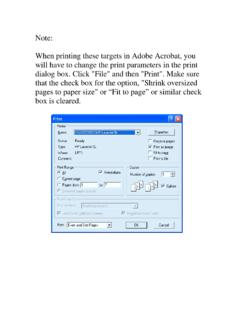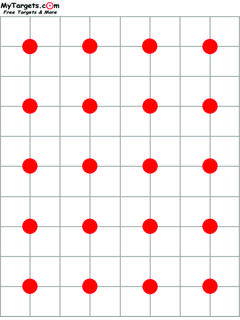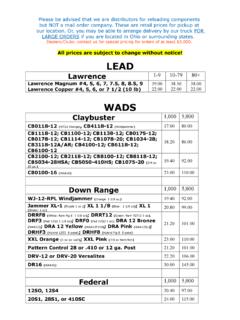Transcription of Instructions for zeroing the PSO-1 and POSP type of scopes ...
1 Instructions for zeroing the PSO-1 and POSP type of scopes with military bore sight your scope: Set your rifle on a steady rest 100 meters (about 109 yards) from your target. Remove the receiver cover, bolt carrier, and cheek pad if you have one. Leave the scope on. Look through the barrel bore and line it up with the target so you can see the bullseye at the end of thebarrel. Now make sure your rifle does not move and carefully look through your scope. If the reticle is not pointing at the bullseye, turn the adjustment drums to align the reticle with thetarget.
2 Reassemble the in the scope: Looking through the scope, align the top chevron (inverted V) with the center of your target. Fire a few shots to determine if your point of aim equals your point of impact (POA = POI). Holding the rifle steady aiming at your target, turn the scope turrets to move the reticle over to yourPOI holes on the target. You may need to repeat this process several times. To avoid chasing your zero take at least three shots between each adjustment of your scope's reticle. Once you have determined your POI = POA you can now adjust the numbered part of the twoadjustment drums on your scope.
3 If the numbers on the turrets do not reflect "1" as your elevation (top drum) and "0" as yourwindage: LOOSEN (do not remove!) the two silver screws (ignore the tiny center screw) on the top of eachturret enough to rotate the numbered part of the drum. Spin the center numbered part of the drums to reflect zero (0) for windage and one (1) for elevationlined up with the black line on each index plate. Re-tighten the screws (hold the top of each drum secure as you do this or it will rotate as you tighteneach screw). Take a few more shots to verify all is correct.
4 POA should now = POI. *Using the built-in range reticle of the military PSO and POSP scopes have a range finder that can be used to determine thedistance to a particular target. Some reticles are calibrated for targets from , , or meters tall,depending on type.** To determine your type of range finder look at the number near the bottom line ofthe the range the target on the bottom horizontal line of the range finder. Where ever the top of the targettouches on the sloping scale is the distance in meters you are from that target.
5 The range finder scale islimited to targets from 200 to 1000 meters away. The above illustration represents a 5' 6 target about250 meters you know the distance to the target, adjust the elevation drum to the corresponding number (2 =200, 3=300, etc.) in meters. From 0 to 3 each click on the elevation drum equals 100 meters, from 3 to10 the clicks equal 50 meter elevation drum adjusts to 1000 meters. For targets beyond that, use the chevrons below the topaiming point in the reticle. Each chevron represents an additional 100 meters in hold over.
6 Windage correction:Because the scope is off-set to the rifle's bore, you may need to make a windage correction fordistances beyond your 100 meter zero. You have two options to accomplish this task. Either turn thewindage drum up or down or use the hash marks to the left and right of the center chevron in thereticle. You simply hold over left or right, aligning your target over a particular hash mark. Each hashmark represents one click on the windage turret which translates to inches of movement at 100meters. *Remember your reticle and elevation drum is calibrated for a projectile around 150 grains and adistance in meters not yards.
7 ** meters = feet, meters = feet, meters = feet 10/09






